STEM Learning in the Woods: Where Curiosity Takes Root
When most people hear ‘STEM education’, they imagine microscopes, lab coats, and computer screens. But step into the woods with a group of curious children, and you’ll find STEM learning happening all around - the rustle of leaves, the flow of water, the height of a stick tower, and the questions that naturally bubble up in the great outdoors.
At Footprints on the Moon, we believe that science, technology, engineering, and maths don’t need to be confined to a classroom. In fact, the natural world offers an ideal environment for developing these skills in meaningful, hands-on ways.
Here’s how STEM learning comes alive in the woods and why it’s such a powerful tool for young explorers.
1) Science sparks wonder around every tree
Children are born scientists. They’re always exploring, observing, experimenting... just watch them follow a trail of ants or notice the shape of clouds!
In Forest School, these everyday moments become rich opportunities for scientific learning. Children might examine a worm’s movements, collect leaves to compare their textures, or explore how water behaves in different containers. They learn to ask thoughtful questions, make predictions, test ideas and reflect on what they find.
It’s science in its purest form - led by curiosity, not curriculum.
2) Real tools, no screens
Forget screens and gadgets - out here, technology looks a little different. Children learn to use ropes, pulleys, magnifying glasses, compasses and hand tools. They figure out how to move water from one place to another, build simple machines using sticks and stones, or experiment with shadows and sunlight.
By using real tools for real purposes, children develop confidence, fine motor skills, and a sense of capability. Technology becomes about solving problems and thinking creatively, not just using devices.
3) Mud, logs and big ideas: engineering through play
Give a child a pile of logs and a bit of freedom, and they’ll start building. Dens, ramps, bridges, obstacle courses - it’s all engineering at play.
In the woods, children plan and construct their own designs, test them, make adjustments, and celebrate when they finally work. Along the way they learn about structure, balance, cause and effect, and most importantly - perseverance.
At Footprints on the Moon, we love watching young minds light up as they figure things out for themselves, one stick and knot at a time.
4) Nature’s numbers: exploring maths in the wild
Maths is everywhere in the woods. Children count acorns, compare stick lengths, sort leaves by size or colour, and estimate distances. They measure ingredients for mud pies, track the growth of a seedling and recognise patterns in nature.
These moments may seem small, but they build the foundations of numeracy in a real-world context. Instead of abstract numbers on a worksheet, children engage with maths in ways that are tactile, visual, and meaningful - making it far more likely to stick.
5) Why STEM in nature works so well
STEM learning outdoors taps into what children do best - explore, build, imagine, and ask questions. It supports creativity, critical thinking and collaboration, all while helping them fall in love with the world around them.
Even better? It boosts confidence. When children see that they can figure something out, solve a problem or create something from scratch, it changes how they see themselves - not just as learners, but as capable, curious people.
Experience STEM the Forest School way
At Footprints on the Moon, we bring STEM to life through play, exploration, and connection to nature. Our Forest School sessions are designed to inspire young minds and support whole-child development. We build academic skills alongside confidence, resilience, and joy!
Want to see STEM learning in action? Join us in the woods
Come for a visit to Footprints on the Moon. Let your child explore, ask questions, build, test, and discover, right under the trees. We’d love to welcome you and show you how learning in the woods can be truly out of this world.




